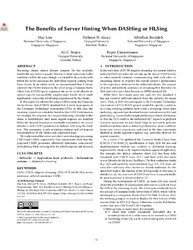The benefits of server hinting when DASHing or HLSing
| dc.contributor.author | Lim, M. | |
| dc.contributor.author | Akçay, Mehmet Necmettin | |
| dc.contributor.author | Bentaleb, A. | |
| dc.contributor.author | Beğen, Ali Cengiz | |
| dc.contributor.author | Zimmermann, R. | |
| dc.date.accessioned | 2023-07-21T05:24:37Z | |
| dc.date.available | 2023-07-21T05:24:37Z | |
| dc.date.issued | 2022-03-17 | |
| dc.identifier.isbn | 978-145039222-8 | |
| dc.identifier.uri | http://hdl.handle.net/10679/8519 | |
| dc.identifier.uri | https://dl.acm.org/doi/10.1145/3510450.3517317 | |
| dc.description.abstract | Streaming clients almost always compete for the available bandwidth and server capacity. Not every client's playback buffer conditions will be the same, though, nor should be the priority with which the server processes the individual requests coming from these clients. In an earlier work, we demonstrated that if clients conveyed their buffer statuses to the server using a Common Media Client Data (CMCD) query argument, the server could allocate its output capacity among all the requests more wisely, which could significantly reduce the rebufferings experienced by the clients. In this paper, we address the same problem using the Common Media Server Data (CMSD) standard that is work-in-progress at the Consumer Technology Association (CTA). In this case, the incoming requests are scheduled based on their CMCD information. For example, the response to a request indicating a healthy buffer status is held/delayed until more urgent requests are handled. When the delayed response is eventually transmitted, the server attaches a new CMSD parameter to indicate how long the delay was. This parameter avoids misinterpretations and subsequent miscalculations by the client's rate-adaptation logic. We implemented the server and client understanding/processing CMCD and CMSD, respectively. Our experiments show that the proposed CMSD parameter effectively eliminates unnecessary downshifting while reducing both the rebuffering rate and duration. | en_US |
| dc.language.iso | eng | en_US |
| dc.publisher | ACM | en_US |
| dc.relation.ispartof | MHV '22: Proceedings of the 1st Mile-High Video Conference | |
| dc.rights | Attribution 4.0 International | * |
| dc.rights | openAccess | |
| dc.rights.uri | http://creativecommons.org/licenses/by/4.0/ | * |
| dc.title | The benefits of server hinting when DASHing or HLSing | en_US |
| dc.type | Conference paper | en_US |
| dc.publicationstatus | Published | en_US |
| dc.contributor.department | Özyeğin University | |
| dc.contributor.authorID | (ORCID 0000-0002-0835-3017 & YÖK ID 217660) Beğen, Ali | |
| dc.contributor.ozuauthor | Beğen, Ali Cengiz | |
| dc.identifier.startpage | 52 | en_US |
| dc.identifier.endpage | 55 | en_US |
| dc.identifier.doi | 10.1145/3510450.3517317 | en_US |
| dc.subject.keywords | Adaptive streaming | en_US |
| dc.subject.keywords | CDN | en_US |
| dc.subject.keywords | CMCD | en_US |
| dc.subject.keywords | CMSD | en_US |
| dc.subject.keywords | DASH | en_US |
| dc.subject.keywords | HLS | en_US |
| dc.subject.keywords | Network assistance | en_US |
| dc.subject.keywords | OTT | en_US |
| dc.subject.keywords | SAND | en_US |
| dc.subject.keywords | Server assistance | en_US |
| dc.identifier.scopus | SCOPUS:2-s2.0-85128038015 | |
| dc.contributor.ozugradstudent | Akçay, Mehmet Necmettin | |
| dc.relation.publicationcategory | Conference Paper - International - Institutional Academic Staff and PhD Student |
Files in this item
This item appears in the following Collection(s)
Share this page




